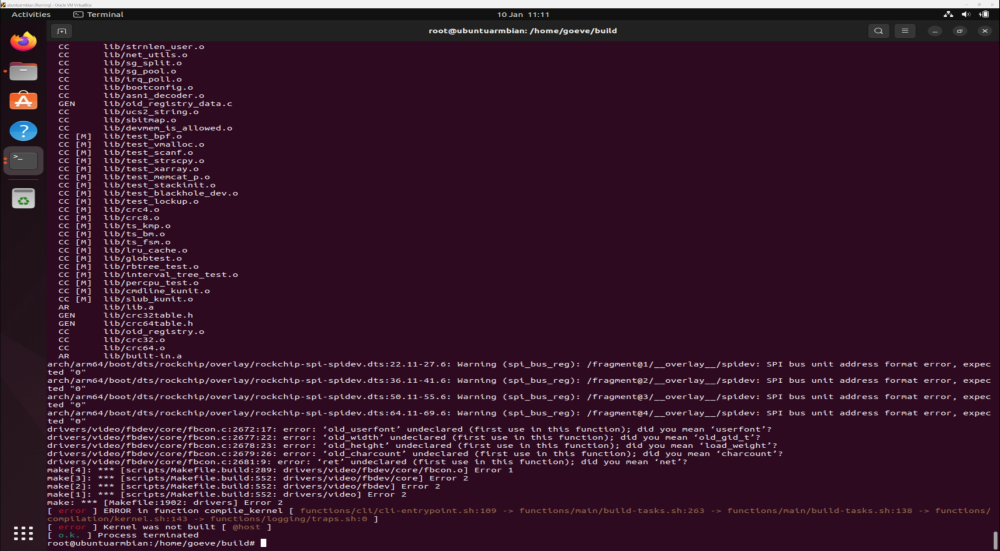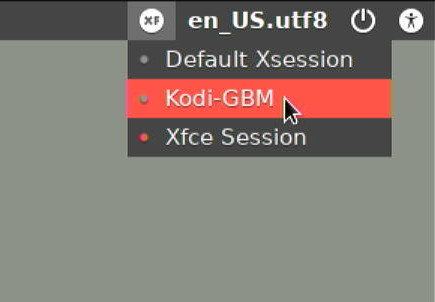Search the Community
Showing results for tags 'rockpi-4b'.
-
Hello There! I'm currently using a Rock 4SE, tagged it as 4B because armbian says I should use the version for the board. I'm using a manually built image of armbian, though without any changes. I'm currently trying to figure out how to get faster boot times on SDDMC. So far: 1 - I've disabled some systemd services. Bluetooth related services have made a big difference. 2 - I've tried to disable USB and network support on U-Boot, though unsuccessful, in order to make U-Boot spend less time before booting the kernel. By applying some patches to U-Boot I got to the point where it either compiles and doesn't start the system because of some runtime error about drivers, or doesn't compile at all. Now I'm currently trying to use suspend mode in order to get faster startup times... The problem is that I'm able to enter suspend mode, but I've got no idea on how to wake the system up. I've searched a lot but couldn't find any definitive answer, so I wanted to at least look for directions here. Here, on the armbian forums, I've seen people talking about modifying the devicetree... Though I have absolutely no idea about what changes should be made in that case. On radxa's forums, all I've seen is people asking but having no answers about how that would work... I'm still awaiting a reply of an e-mail I sent to dev@radxa.com. Does the fact that the system supports going into suspend mode implies it has a way to wakeup? If so, is the devicetree the only thing that needs to be modified in order for it to wakeup? Can any GPIO be used for wakeup functionality? Or does it need to be a specific pin? Did anyone get a rockpi board to wakeup from suspend mode??
-
Hello, I am new to Armbian and Linux and want to set up my raspberry pi camera module 2 for my rock pi4b so I can start doing computer vision work. Does anyone know how to do this?
-
Hi, i just received my Rock 4 Se and a 32GB eMMC module today, and i'm currently not sure if the Image is incompatible, or if my storage modules are broken. I tried emmc standalone and SD for boot with nvme (from an dell notebook) for rootfs When i use the emmc, the filesystem goes into read only as soon as i do some apt upgrade. On reboot i often end up in initramfs nd have to fsck. I could gether some dmesg output: After this trace i get a lot of I/O Errors: Im not sure if this is an os or an emmc module issue. Any guess whats going wrong here? after that i coppied the current image ( Armbian_22.11.1_Rockpi-4b_bullseye_current_5.15.80.img.xz) onto a micro SD card, addedthe nvme drive, bootet that and made an armbian-install to migrate the rootfs to the nvme. After a reboot, i could actually start to instlall software. But after a while i still had some freeze of the whole system, so i had to power the board off and turn it on again. Sadly i do not have any more output from this situation. i'm also going to try a version with older kernel, will reportlater if that worked
-
Hi I want to modify base armbian image using choot in order to install necessary software. I am also creating user during that process. My question is how can I skip or prefill the form that appears on first run? (user creation, time zone setting etc.) I was surfing the forum and found this answer. So, I came up with few options: 1) It looks like I can prefill my desired values for the form in "/usr/lib/armbian/armbian_firstlogin" file by editing it during chroot 2) I can remove user input parts in "/usr/lib/armbian/armbian_firstlogin", but preserve other important lines, since user will be created during chroot Is this valid options or there is more proper way to do this?
-
I enabled spi-spidev through armbian-config but it does not show in the /dev/ directory. How do i fix this?
-
I am in the process to migrate a project from a Raspberry Pi 4B to a Rock Pi 4B+. Among others external devices shall be connected via WiFi AP, I2C, 1-Wire and UART to the Rock Pi. To emphasis, the system is running healthy on a Rasberry. I managed to get WiFi AP and 1-Wire up and running on the Rock Pi. Now I got stuck with UART/UART4. Armbian 22.11.1 Bullseye with Linux 5.15.80-rockchip64 I enabled UART4 via Armbian-Config. Therefore, /boot/armbianEnv.txt shows: ... overlays=i2c7 uart4 w1-gpio param_w1_pin=GPIO4_D6 param_w1_pin_int_pullup=1 ... I can take a jump wire and bridge the TX-pin (GPIO1_B0, Pin#19) and RX-pin (GPIO1_A7, Pin#21). When sending bytes to the TX-pin I am receiving them instantly on the RX-Pin. That indicates to me the UART4 is working. On my system the serial port is /dev/ttyS4, with a baud rate of 1000!!. (I am doing this test via Node Red using a standard serial node) However, if I connect my TTL-signal cable to the RX-pin (TX disconnected), I do not see anything the RX-Pin (however this setup works on the Rasberry). I have done the same test on UART (/dev/ttyS2) with same result, not showing anything. I have no experience in Armbian or Rock Pi and would appreciate any hint into which direction to look. Is the unusual baud rate of 1000 a problem, or do I need some pull-up resistors or do I need to compile another dtbo driver like for the 1-wire?
-
Hi just a quick question What package is dt-bindings normally located in, i would assume kernel headers but i tried installation via armbian-config and couldn't see them. Can anyone confirm what package it normally is in or was i blind thanks. Was just working on adding support Waveshare Dual RS232 on SPI2, uploaded DTS to https://github.com/radxa/overlays/blob/main/arch/arm64/boot/dts/rockchip/overlays/rk3399-spi2-sc16is752.dts Atm i hardcoded the defines on machine but not ideal if it changes in the future Thanks
-
Hello everyone, I was going to purchase Rock Pi 4 model B+ (with WiFi/BT and eMMC chip). I see that Rock Pi 4 family is supported by Armbian (https://www.armbian.com/rockpi4/), however, there is no mention of models A+ and B+. There are just A, B and C+. Could you please confirm/refute that Rock Pi 4 B+ is supported by Armbian and point me to the image for that model?
-
Hi guys, I am building armbian image for rockpi4b+ and its kernel is 6.0.11(edge version) and the bluetooth failed start up. If anyone knows what kernel 6.0.11 did that cause the problem: wzkiro@rockpi-4bplus:~$ dmesg | grep brcm [ 7.069061] brcmfmac: F1 signature read @0x18000000=0x15294345 [ 7.108688] brcmfmac: brcmf_fw_alloc_request: using brcm/brcmfmac43456-sdio for chip BCM4345/9 [ 7.109142] usbcore: registered new interface driver brcmfmac [ 7.236547] brcmfmac: brcmf_fw_alloc_request: using brcm/brcmfmac43456-sdio for chip BCM4345/9 [ 7.245940] brcmfmac: brcmf_c_preinit_dcmds: Firmware: BCM4345/9 wl0: Feb 11 2020 11:54:51 version 7.45.96.61 (be7af2d@shgit) (r745790) FWID 01-a41d86bd es7.c5.n4.a3 wzkiro@rockpi-4bplus:~$ dmesg | grep Bluetooth [ 7.089775] Bluetooth: Core ver 2.22 [ 7.089894] Bluetooth: HCI device and connection manager initialized [ 7.089914] Bluetooth: HCI socket layer initialized [ 7.089922] Bluetooth: L2CAP socket layer initialized [ 7.089943] Bluetooth: SCO socket layer initialized [ 7.394043] Bluetooth: HCI UART driver ver 2.3 [ 7.394074] Bluetooth: HCI UART protocol H4 registered [ 7.394081] Bluetooth: HCI UART protocol BCSP registered [ 7.403820] Bluetooth: HCI UART protocol LL registered [ 7.403831] Bluetooth: HCI UART protocol ATH3K registered [ 7.405384] Bluetooth: HCI UART protocol Three-wire (H5) registered [ 7.416771] Bluetooth: HCI UART protocol Intel registered [ 7.440646] Bluetooth: HCI UART protocol Broadcom registered [ 7.453388] Bluetooth: HCI UART protocol QCA registered [ 7.453410] Bluetooth: HCI UART protocol AG6XX registered [ 7.459664] Bluetooth: HCI UART protocol Marvell registered [ 9.738700] Bluetooth: hci0: command 0xfc18 tx timeout [ 13.642153] Bluetooth: BNEP (Ethernet Emulation) ver 1.3 [ 13.642193] Bluetooth: BNEP filters: protocol multicast [ 13.642220] Bluetooth: BNEP socket layer initialized [ 17.894543] Bluetooth: hci0: BCM: failed to write update baudrate (-110) [ 17.894570] Bluetooth: hci0: Failed to set baudrate [ 19.910475] Bluetooth: hci0: command 0x0c03 tx timeout [ 28.484626] Bluetooth: hci0: BCM: Reset failed (-110)
-
Hi, my current CI build fails, and i cannot make up, whats wrong with it. It was working previously until i moved my project within the GitLab instance to another folder. Now i'm getting the following errors: tail output.log OBJCOPY lib/efi_loader/dtbdump.efi CC lib/vsprintf.o CC lib/strto.o CC lib/abuf.o OBJCOPY lib/efi_loader/initrddump.efi CC lib/date.o CC lib/rtc-lib.o CC lib/elf.o AR lib/built-in.o [ error ] ERROR in function compile_uboot [ functions/cli/cli-entrypoint.sh:109 -> functions/main/build-tasks.sh:261 -> functions/main/build-tasks.sh:128 -> functions/compilation/uboot.sh:131 -> functions/logging/traps.sh:0 ] [ error ] U-boot compilation failed [ o.k. ] Process terminated # somewhere in the middle of the compilation.log CC cmd/sf.o AR drivers/nvme/built-in.o AR drivers/power/battery/built-in.o AR drivers/power/fuel_gauge/built-in.o CC cmd/sysboot.o drivers/net/phy/phy.c: In function ‘get_phy_driver’: drivers/net/phy/phy.c:652:15: error: ‘YT_8531C_PHY_ID’ undeclared (first use in this function) 652 | if(phy_id == YT_8531C_PHY_ID) | ^~~~~~~~~~~~~~~ drivers/net/phy/phy.c:652:15: note: each undeclared identifier is reported only once for each function > AR drivers/power/mfd/built-in.o make[3]: *** [scripts/Makefile.build:254: drivers/net/phy/phy.o] Error 1 make[2]: *** [scripts/Makefile.build:394: drivers/net/phy] Error 2 make[2]: *** Waiting for unfinished jobs.... CC drivers/pinctrl/pinctrl-uclass.o CC drivers/power/pmic/pmic-uclass.o CC drivers/power/regulator/regulator-uclass.o tail compilation.log CC drivers/video/panel-uclass.o CC drivers/video/simple_panel.o TTF drivers/video/u_boot_logo.S OBJCOPY lib/efi_loader/initrddump.efi CC drivers/video/dw_hdmi.o AR lib/built-in.o AS drivers/video/u_boot_logo.o AR drivers/video/rockchip/built-in.o AR drivers/video/built-in.o make: *** [Makefile:1894: drivers] Error 2 I have tried to switch the repo mirrors, or different tags. I even deleted the entire checked out directory (build) and checked it out again. After cloning the repo and running the compile script with my config-default.config i'm ending up with the same error. Any idea, what could be wrong? I already checked the permissions (actually I'm running the compile script as root). It seems there is some issue with the network driver? my config-default.conf # Read build script documentation https://docs.armbian.com/Developer-Guide_Build-Options/ # for detailed explanation of these options and for additional options not listed here # leave empty to select each time, set to "yes" or "no"> KERNEL_ONLY="no" # leave empty to select each time, set to "yes" or "no" to skip> KERNEL_CONFIGURE="no" # comma-separated list of clean targets: "make" = make clean for select> # "debs" = delete packages in "./output> # "alldebs" = delete all packages in ".> # "cache" = delete "./output/cache", "s> # "oldcache" = remove old cached rootfs> CLEAN_LEVEL="make,debs,cache" # yes: use kernel config file from previous compilation for the same branch, device family and version # no: use default or user-provided config file KERNEL_KEEP_CONFIG="yes" # comma-separated list of core modules which will be installed > # "u-boot", "kernel", "bsp", "armbian-config", "armbian-firmwar> # leave empty to build from sources or use local cache REPOSITORY_INSTALL="" BUILD_DESKTOP="yes" DEST_LANG="de_DE.UTF-8" # advanced # compile and install or install prebuilt additional packages EXTERNAL_NEW="prebuilt" # change to "branchname" to use any branch currently available. LIB_TAG="v22.08" # additions to compile 'unattended' DESKTOP_ENVIRONMENT="xfce" DESKTOP_APPGROUPS_SELECTED="editors, internet" DESKTOP_ENVIRONMENT_CONFIG_NAME="config_base" # additions to compile for the rock-pi4 BOARD="rockpi-4b" BRANCH="current" RELEASE="bullseye" # yes: will stop the script and prompt for adding userpatches (kernel, u-boot) CREATE_PATCHES="no" # creates logs in output/debug PROGRESS_LOG_TO_FILE="yes" # set to yes, to prevent cloning from git OFFLINE_WORK="no" # provides a faster download USE_MAINLINE_GOOGLE_MIRROR="yes" USE_GITHUB_UBOOT_MIRROR="yes" # create compressed archive with image file and GPG signature f> # yes - compatibility shorcut for sha,gpg,7z COMPRESS_OUTPUTIMAGE="yes"
-
tried several armbian images with kernel 5.15.76, no success! even tried to disable SPI flash, although radxa says "no SPI Flash on the board" in contrast to the 4B version official 4.4 radxa image is booting: rockpi-4b-debian-bullseye-xfce4-arm64-20221109-1447-gpt.img can someone send me armbian bullseye image with older kernel?
-
Hello, Devices: RockPi 4b v1.5 + remotable eMMC + NVMe KingSpec M.2 NMVe SSD NE 2280 512 GB I am using instructions to erase SPI https://wiki.radxa.com/Rockpi4/dev/spi-install $ sudo rkdeveloptool ld DevNo=1 Vid=0x2207,Pid=0x330c,LocationID=103 Maskrom $ sudo rkdeveloptool db ./rk3399_loader_spinor_v1.20.126.bin Downloading bootloader succeeded. $ dd if=/dev/zero of=./zero.img bs=1M count=4 4+0 records in 4+0 records out 4194304 bytes (4.2 MB, 4.0 MiB) copied, 0.0160027 s, 262 MB/s $ sudo rkdeveloptool wl 0 ./zero.img Write LBA from file (100%) $ sudo rkdeveloptool td Test Device OK. $ sudo rkdeveloptool rd Reset Device OK. After that, insert eMMC and use instruction to write image to eMMChttps://wiki.radxa.com/Rockpi4/dev/usb-install $ sudo rkdeveloptool ld DevNo=1 Vid=0x2207,Pid=0x330c,LocationID=103 Maskrom $ sudo rkdeveloptool db ./rk3399_loader_v1.20.119.bin Downloading bootloader succeeded. $ sudo rkdeveloptool wl 0 ./Armbian_22.08.8_Rockpi-4b_bullseye_current_5.15.76.img Write LBA from file (100%) $ sudo rkdeveloptool rd Reset Device OK. After reboot device work fine. But if I insert NVMe the system not booting, blue led just blinking and that all. I tryed several images: Armbian_22.11.0-trunk_Rockpi-4b_bullseye_current_5.15.76_minimal.img Armbian_22.08.8_Rockpi-4b_bullseye_current_5.15.76.img rockpi-4b-debian-bullseye-xfce4-arm64-20221101-0519-gpt.img rockpi-4b-debian-buster-xfce4-arm64-20220401-0335-gpt.img The main goal is system on eMMC and stored data on NVMe (like mini NAS) Also if I use armbian-install have the same issue. Any help with it ?
-
Hi! After update to kernel 5.15.75 via apt upgrade, boot fails. Though I can flash an older image, I would prefer trying to recover existing setup and rollback to a previous kernel. What would be the best approach, ie flash image to usb, boot from usb and what then? I will appreciate any advice. U-Boot 2022.07-armbian (Oct 18 2022 - 07:36:22 +0000)SoC: Rockchip rk3399Reset cause: PORModel: Radxa ROCK Pi 4BDRAM: 3.9 GiBPMIC: RK808Core: 285 devices, 31 uclasses, devicetree: separateMMC: mmc@fe310000: 2, mmc@fe320000: 1, mmc@fe330000: 0Loading Environment from SPIFlash... jedec_spi_nor flash@0: unrecognized JEDEC id bytes: ff, ff, ff*** Warning - spi_flash_probe_bus_cs() failed, using default environmentIn: serialOut: serialErr: serialModel: Radxa ROCK Pi 4BNet: eth0: ethernet@fe300000Hit any key to stop autoboot: 0starting USB...Bus usb@fe380000: ehci_generic usb@fe380000: Failed to get clocks (ret=-19)Port not available.Bus usb@fe3c0000: ehci_generic usb@fe3c0000: Failed to get clocks (ret=-19)Port not available.Bus usb@fe800000: Register 2000140 NbrPorts 2Starting the controllerUSB XHCI 1.10Bus usb@fe900000: Register 2000140 NbrPorts 2Starting the controllerUSB XHCI 1.10scanning bus usb@fe800000 for devices... 1 USB Device(s) foundscanning bus usb@fe900000 for devices... 1 USB Device(s) found scanning usb for storage devices... 0 Storage Device(s) foundDevice 0: unknown deviceCard did not respond to voltage select! : -110switch to partitions #0, OKmmc0(part 0) is current deviceScanning mmc 0:1...Found U-Boot script /boot/boot.scr3185 bytes read in 19 ms (163.1 KiB/s)## Executing script at 00500000Boot script loaded from mmc 0266 bytes read in 15 ms (16.6 KiB/s)17307706 bytes read in 1665 ms (9.9 MiB/s)30540288 bytes read in 2916 ms (10 MiB/s)76240 bytes read in 48 ms (1.5 MiB/s)376 bytes read in 37 ms (9.8 KiB/s)Applying kernel provided DT overlay rockchip-rk3399-opp-2ghz.dtbo1314 bytes read in 44 ms (28.3 KiB/s)Applying kernel provided DT overlay rockchip-spi-jedec-nor.dtbo2698 bytes read in 39 ms (67.4 KiB/s)Applying kernel provided DT fixup script (rockchip-fixup.scr)## Executing script at 09000000Moving Image from 0x2080000 to 0x2200000, end=3fc0000## Loading init Ramdisk from Legacy Image at 06000000 ... Image Name: uInitrd Image Type: AArch64 Linux RAMDisk Image (gzip compressed) Data Size: 17307642 Bytes = 16.5 MiB Load Address: 00000000 Entry Point: 00000000 Verifying Checksum ... OK## Flattened Device Tree blob at 01f00000 Booting using the fdt blob at 0x1f00000 Loading Ramdisk to f0e8a000, end f1f0b7fa ... OK Loading Device Tree to 00000000f0e0f000, end 00000000f0e89fff ... OKStarting kernel ...efi_free_pool: illegal free 0x00000000f0f0d040efi_free_pool: illegal free 0x00000000f0f0a040[ 3.806881] Internal error: implementation fault (unsupported exclusive): 96000035 [#1] PREEMPT SMP[ 3.807711] Modules linked in:[ 3.808001] CPU: 2 PID: 224 Comm: kworker/u12:4 Not tainted 5.15.75-rockchip64 #22.08.8[ 3.808728] Hardware name: Radxa ROCK Pi 4B (DT)[ 3.809152] Workqueue: events_unbound deferred_probe_work_func[ 3.809698] pstate: 80000005 (Nzcv daif -PAN -UAO -TCO -DIT -SSBS BTYPE=--)[ 3.810334] pc : ww_mutex_lock_interruptible+0x1a4/0x308[ 3.810830] lr : phy_power_off+0x28/0xd8[ 3.811200] sp : ffff80000a713ab0[ 3.811505] x29: ffff80000a713ab0 x28: 00000000fffffffe x27: 0000000000a000c4[ 3.812167] x26: 0000000000a000c4 x25: 0000000010624dd3 x24: 0000000000900004[ 3.812828] x23: 0000000000900004 x22: 0000000000000000 x21: ffff80000f000300[ 3.813489] x20: 00000000e2808257 x19: ffff80000f000000 x18: 0000000000000001[ 3.814149] x17: 7469772074756f65 x16: 6d697420316e6567 x15: 00000000000001b5[ 3.814810] x14: ffff80000a713730 x13: 00000000ffffffea x12: ffff800009b1fd10[ 3.815472] x11: 0000000000000003 x10: ffff800009b07cd0 x9 : ffff800009b07d28[ 3.816133] x8 : 0000000000017fe8 x7 : c0000000ffffefff x6 : 0000000000000001[ 3.816793] x5 : 0000000000057fa8 x4 : 0000000000000000 x3 : ffff80000f000300[ 3.817453] x2 : ffff00000120d880 x1 : 0000000000000000 x0 : ffff80000f000300[ 3.818113] Call trace:[ 3.818341] ww_mutex_lock_interruptible+0x1a4/0x308[ 3.818803] phy_power_off+0x28/0xd8[ 3.819142] rockchip_pcie_host_init_port+0x564/0x5a0[ 3.819616] rockchip_pcie_probe+0xf8/0x4c0[ 3.820011] platform_probe+0x68/0xd8[ 3.820359] really_probe+0xbc/0x428[ 3.820696] __driver_probe_device+0x114/0x188[ 3.821111] driver_probe_device+0xb0/0x110[ 3.821502] __device_attach_driver+0xbc/0x158[ 3.821917] bus_for_each_drv+0x7c/0xd0[ 3.822284] __device_attach+0xec/0x1a8[ 3.822644] device_initial_probe+0x14/0x20[ 3.823036] bus_probe_device+0x9c/0xa8[ 3.823396] deferred_probe_work_func+0x9c/0xf0[ 3.823817] process_one_work+0x20c/0x4c8[ 3.824199] worker_thread+0x208/0x478[ 3.824554] kthread+0x138/0x150[ 3.824863] ret_from_fork+0x10/0x20[ 3.825211] Code: c8017e60 35ffffa1 17fffd08 f9800071 (c85ffc60)[ 3.825769] ---[ end trace a4970fb3a1b23494 ]---
-
Hello, how to get I2C-2 device support in overlay? I have checked /boot/dtb/rockchip/overlay/README.rockchip-overlays and only i2c-7 and i2c-8 seems to be there. GPIO pins are here GPIO2_A0 and GPIO2_A1 https://wiki.radxa.com/Rockpi4/hardware/gpio#Rock_Pi_4A_.2F_4A_Plus_.2F_4B_.2F_4B_Plus_.2F_4C_.2F_4C_Plus.28.3E.3DV1.2.29_general_purpose_input-output_.28GPIO.29_connector Thank you!
-
IT'S FINALLY HERE... THE OFFICIAL ROCKCHIP-LEGACY MULTIMEDIA INTEGRATION After two years of using a separate script to enable the multimedia features in RK3399 Legacy Kernel, the whole framework has been incorporated to the official Armbian packaging system. The choice distro for this integration is Debian Buster (see FAQ at the end of this post about the reasons). I. Installation Download a Armbian Buster Legacy Desktop image for your board, and install it with the standard Armbian method. Install the complete multimedia solution with sudo apt update && sudo apt upgrade sudo apt install media-buster-legacy-rk3399 --install-recommends The switch "--install-recommends" will add the whole Kodi binary addons collection (retro-gaming cores, music visualizations, screensavers, additional media decoders/encoders, vfs, etc.), plus the GLES-to-OpenGL wrapper "gl4es". II. Features Accelerated GLES/EGL X desktop: No action needed. Accelerated Chromium, with WebGL and video display acceleration: No action needed Desktop video player capable of smooth 4K HEVC-HDR: Use the "Rockchip Gst Player" from the Multimedia menu, or choose it with right-click on the media file. Command-line 4K playing is also possible with "gst-play-1.0 --videosink=kmssink". RKMPP-accelerated MPV: Use normally for standard operation (windowed with mouse-operated GUI). For fullscreen, keyboard-operated mode, use the command line switch "--gpu-context=drm" (this will allow you to play smooth 4K). - See instructions below, in the next post, for playing YouTube videos up to 4K with this MPV. ISP Camera with real-time h.264/1080p HW encoding: Using the Gstreamer Plugin. Check this wiki for instructions on how to use it. Most of it applies to Armbian, except for the selection of ov5647/imx219 camera, which must be done using DT overlays. OpenCL 1.2 support: It will be fully functional, no further action needed. You can download some tests and examples from this link. Kodi 18.9 Leia with full RKMPP+GBM acceleration, 4K-HDR capable: You can start it from LightDM menu as your user account: Alternatively, you can also run it as a system service with these command lines: sudo systemctl disable lightdm sudo systemctl enable kodi-gbm sudo reboot Full collection of Kodi binary add-ons: Includes retrogaming cores, media encoders and decoders, PVR, screensavers, vfs and audio visualizations. They are all installed with the package "kodi-addons-full", but are disabled by default. They need to be enabled individually within the Kodi GUI. OpenGL 2.1 support through the gl4es wrapper: It is installed with the package "gl4es", with no further action needed. III. Sources This is the list of the sources used for the packages: IV. FAQ ¿Why did you use Debian Buster as a base for this implementation? It was the most appropriate for several reasons. Upstream Rockchip-Linux developers use Debian buster, so the software could be ported with less modifications than if we chose a different distro. Besides, it is a completely stable distro, unlike Bullseye, which is a moving target as of today. It also has Chromium as a package, unlike Focal that uses snap instead. For last, it has a good backports repo, with several libs that would otherwise need to be compiled and maintained if we chose, for example, Focal. ¿Why Legacy instead of Mainline? This is an implementation based on the vendor's BSP kernel. It has been tested and is reliable, which many people will prefer rather than having a bleeding-edge, less stable implementation. In addition to that, Mainline upstream multimedia support is still a WIP, and lacks many features that are only present on Legacy kernels. ¿Will you add new features to this implementation? No, this implementation will only receive bug fixes if necessary. From now on, all multimedia work will be focused on Mainline and recent distros (like Focal or Bullseye). All new features will go there.
- 251 replies
-
11
-
- Orange Pi 4
- ROCKPro64
-
(and 1 more)
Tagged with:
-
With Armbian v20.11 one can write mainline u-boot image to board's SPI and enjoy booting nvme drives without any mmc devices. Prerequisities: ROCK Pi 4(A/B/C) v1.4 or 1.3 with SPI soldered in (v1.3 comes without SPI flash from the factory). If you already have Radxa's u-boot written to SPI you need to short pins 23 and 25 for Armbian to boot Boot fresh image of Armbian v20.11.x for ROCK Pi 4(A/B/C) Add the following lines to /boot/armbianEnv.txt overlays=spi-jedec-nor param_spinor_spi_bus=1 Reboot If you shorted 23-25 pins in 1.) then: disconnect them after the ROCK Pi 4 fully boot's enable spi-nor by executing (as root): echo spi1.0 > /sys/bus/spi/drivers/spi-nor/bind verify that the SPI mtd interface is enabled by running ls /dev/mtdblock0 if the last command does not list any file then something went wrong between 3.) and 5.) Run nand-sata-install choose option: "Boot from SPI - system on SATA, USB or NVMe" choose NVMe partition, eg. /dev/nvme0n1p1 accept erasing of the choosen partition with "Yes" choose fs type (tested with ext4) wait a few minutes for rootfs transfer to chosen partition choose writing SPI bootloader with "Yes" confirm that you want to flash it with "Yes" wait ~60 seconds for writing choose Exit Reboot Enjoy Armbian booting with SPI / NVMe Why bother with mainline u-boot? It is known to boot some NVMe drives that legacy u-boot from Radxa has issues with, eg. SAMSUNG 970 EVO Plus and SAMSUNG PM981. This does not mean that all NVMe drives are supported, YMMV. Which NVMe drives are known to be working? Corsair MP510 240GB/480GB/960GB Gigabyte SSD M.2 2280 PCIe x2 Model:GP-GSM2NE8128GNTD HP SSD EX900 M.2 NVMe 120GB. Model: 2YY42AA#ABB Intel SSD 660p Model:SSDPEKNW512GB Kingston A1000 SSD 240GB (PHISON PS5008-E8-10) Kingston A2000 M.2 2280 PCIe NVMe PNY 250GB XLR8 CS3030 M.2 NVMe SSD PCIe Gen3 x4 Sabrent Rocket 256GB NVMe PCIe M.2 2280 Samsung 970 EVO Plus SSD 250GB M.2 2280, PCIe 3.0 x4, NVMe, 3500/2300 MB/s Samsung PM981 256GB XPG SX6000 Lite 128GB (ASX6000LNP-128GT-C) Why not using Radxa's u-boot SPI image? Ambian's u-boot configuration is incompatible with Radxa's SPI image Why Armbian is using u-boot that is incompatible with Radxa's? It uses mainline u-boot with Open Source TPL/SPL/proper and BL31 from Rockchip packaged into u-boot and we may switch to using open source ATF instead of the BL31 in the future. Can I boot Radxa's images with Armbian's u-boot written to SPI? Yes. Armbian's SPI u-boot is compatible with Radxa's images available here: https://github.com/radxa/rock-pi-images-released/releases It may not be compatible with some older images (released before July 2020) because of the device tree filename change.
-
Hi, I'm new to armbian and I've started with RockPi4b board. I would like to add fan control with PWM, but adding pwm (or pwm0) overlay doesn't work. I can't also find the overlay for it at /boot/dtb-5.8.6-rockchip64/rockchip/overlay/. Is it supported? I've checked and the /sys/class/pwm/pwmchip0 is present, but accessing export, as described here : doesn't work and /sys/class/pwm/pwmchip0/pwm0 is not present. I've tried to find pwm access examples for this board, but none of it works on armbian (all are vendor builds specific). Can anybody point me in the right direction or give any hint how to enable pwm? EDIT : I've managed to enable/dosable PWM pin with sudo mraa-gpio set 11 1 Although, its GPIO, rather PWM access so I can't control the FAN speed and only power on/off the fan.






